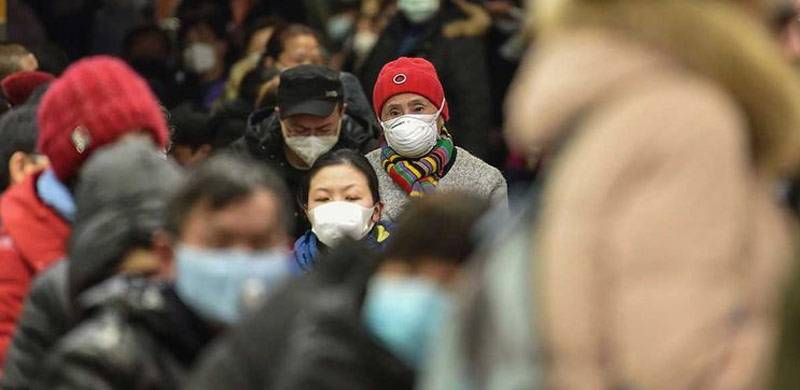
WHO has declared Coronavirus a pandemic. It has spread to more than 140 countries around the world. The number of cases has risen to 100,000 and more than 5700 people have died. Most of the information on the internet isn’t factually correct and is bereft of the main context. The fatality rate is just 1-3 percent, and in some scenarios it can reach up to 6.5 percent. The number of cases per day is dropping rapidly in China but rising exponentially in all other parts of the world.
As the world’s 8th largest economy, Italy, goes into lockdown and US, South Korea, UK, and others embrace for its impact, Pakistan, which shares a border not only with China (the epicenter of the outbreak) but also with Iran, which has seen a drastic rise in the number of cases and deaths both, is also at the risk of being taken over by the pandemic.
At the time of writing, the number of cases here in Pakistan stands at 28, and the number of suspected ones is 76. Life is going on as usual. However, this shouldn’t be the case. The following statistical analysis and data will show you why we need to be proactive.
Tomas Peuyo has written an incredibly insightful analysis of the current outbreak and presented eye-opening conclusions regarding the virus and its spread. We have mainly derived our analysis regarding the number of cases etcetera from the mathematical model shared by the writer in his article.
I worked with Ahsan Zahid; an engineer, tech enthusiast with a profound interest and expertise in data sciences, to provide our readers a perspective regarding the spread of the virus here in Pakistan. He helped me work out the numbers in Pakistan and provide some actionable insights.
The most important point that he highlights is the difference between reported cases (the cases that have been confirmed by the authorities) and the number of true cases (actual number of cases).
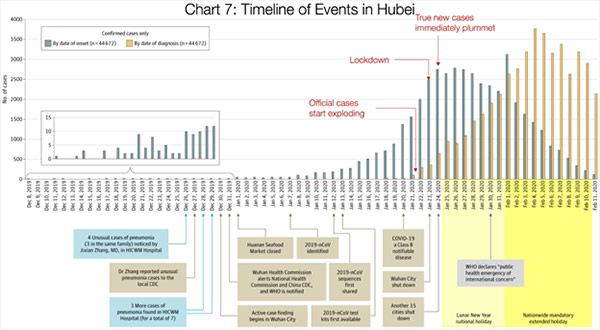
In the above graph the orange lines represent the cases known to the authorities and the grey ones the true cases (methodology explained in the link). We can see how the number of true cases starts to explode after 21st January and then starts dropping after the lockdown begins. Close observation would tell us that Chinese authorities started the lockdown at about 400 reported - whereas, in fact, the number of total cases at that stage was 2500! This shows the proactive approach of China and explains the steep fall in the number of cases afterward. They have done what is almost impossible to be emulated by another country.
Now consider Pakistan. In the article above there are two ways to predict the number of true cases. One is through deaths and the other through reported cases. Fortunately, no deaths have been reported in Pakistan as of today. So we will use the other method.
This forecasting is based on the average growth rate of cases days after the outbreak in the US, UK, Germany (DE), France (FR), Spain (ES), Italy (IT), Iran (IR), South Korea (SK), Japan (JP), and Switzerland (CH). The number of deaths has been calculated at a fatality rate of 0.87%.
At the time of writing of this article, 94 cases have been confirmed in Pakistan and applying Tomas Peuyo model gives us the following results, assuming that community spread is happening.
From this model, we can predict that without intervention the number of infected cases can reach tens of thousands within a month after an outbreak. So it’s not just the intervention that will help, but it has to be a timely one too!
Measures must be taken aggressively, especially on the issue of general testing. Proactive measures (for which we are already late) are very critical as they help flatten the curve. The point of this model is not to forecast the future but to develop an understanding of what needs fixing. Other countries have also proven that timely response can bend the epidemic curve (as shown in the graphs below).
If there are 1 million people in the area of these infected persons and a company has 500 employees. The current infection rate is 0.074% which will increase to 0.25% by next week and there are 71% chances that at least one or more of that company’s employees will suffer from Coronavirus by next week. This percentage will increase drastically. In this scenario that company should be forced to close immediately. This case can be applied to any school or organization.
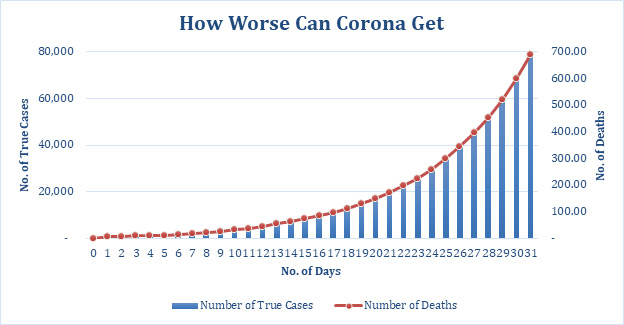
Pakistan should not delay and already start preparing for a lockdown. Social distancing is the best and most potent solution to this problem. Offices should prepare for arrangements to give employees the facility to work from home. Public gatherings should be banned.
Here is an illustration of how much difference even a single day delay of lockdown can make.
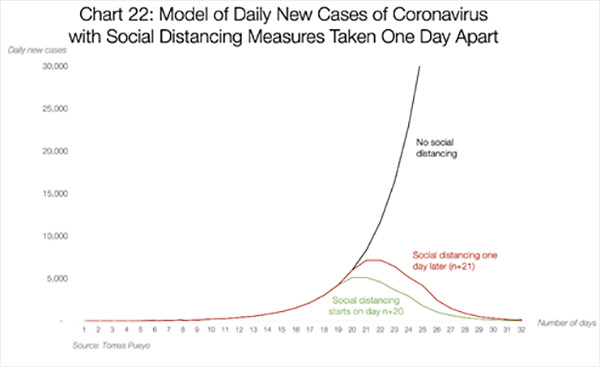
If you are wondering what is the difference in percentage increase of cases for a single day delay in a lockdown:
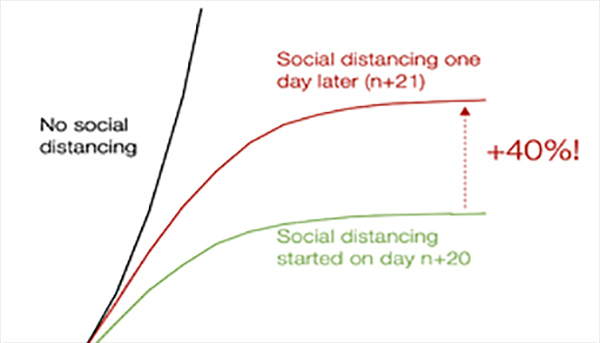
There are also rumors that doctors are receiving Coronavirus cases on a daily basis but none of them is being reported. So, the above number can go much higher as we don’t even have a true tally of reported cases.
Can Pakistan’s healthcare system handle the Corona outbreak? It is hard to say yes to this question.
For this purpose, Ahsan and I got the estimates for the total number of beds available and compared it with the rise in cases.
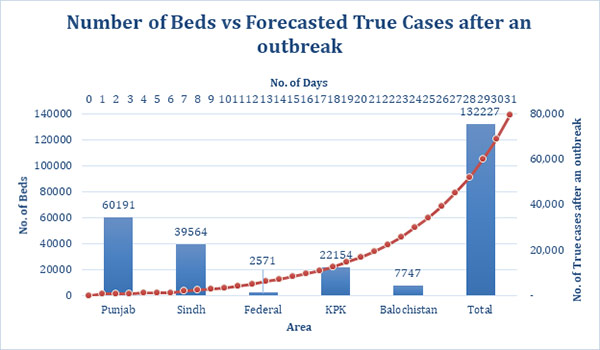
(The data for the number of beds of the year 2018 is taken from Pakistan Bureau of Statistics).
An exponential increase in the number of cases per day will result in a sharper curve resulting in an acute shortage of beds and medical equipment against the infected people. Steps should be taken to slow down the spread as much as possible. There is a dire need to seek help from China to get testing kits and other necessary tools. We might even have to import human resources (doctors) that are required to carry out the testing.
We need to get help from computer scientists to develop algorithms; dividing the cities into blocs and suggesting the amount of personnel and time required to carry out a testing campaign there.
It is satisfying to see that our government has started to take necessary and required steps to stop the spread (though, it was a bit late). These steps should be lauded and authorities and individuals should be encouraged to play their part. This is a collective responsibility. Much more needs to be done.
Finally, for those who are still non-serious: a vaccination for this virus will be developed sooner or later; however, there won’t be one for negligence and careless attitudes.
As the world’s 8th largest economy, Italy, goes into lockdown and US, South Korea, UK, and others embrace for its impact, Pakistan, which shares a border not only with China (the epicenter of the outbreak) but also with Iran, which has seen a drastic rise in the number of cases and deaths both, is also at the risk of being taken over by the pandemic.
At the time of writing, the number of cases here in Pakistan stands at 28, and the number of suspected ones is 76. Life is going on as usual. However, this shouldn’t be the case. The following statistical analysis and data will show you why we need to be proactive.
Tomas Peuyo has written an incredibly insightful analysis of the current outbreak and presented eye-opening conclusions regarding the virus and its spread. We have mainly derived our analysis regarding the number of cases etcetera from the mathematical model shared by the writer in his article.
I worked with Ahsan Zahid; an engineer, tech enthusiast with a profound interest and expertise in data sciences, to provide our readers a perspective regarding the spread of the virus here in Pakistan. He helped me work out the numbers in Pakistan and provide some actionable insights.
The most important point that he highlights is the difference between reported cases (the cases that have been confirmed by the authorities) and the number of true cases (actual number of cases).

In the above graph the orange lines represent the cases known to the authorities and the grey ones the true cases (methodology explained in the link). We can see how the number of true cases starts to explode after 21st January and then starts dropping after the lockdown begins. Close observation would tell us that Chinese authorities started the lockdown at about 400 reported - whereas, in fact, the number of total cases at that stage was 2500! This shows the proactive approach of China and explains the steep fall in the number of cases afterward. They have done what is almost impossible to be emulated by another country.
Now consider Pakistan. In the article above there are two ways to predict the number of true cases. One is through deaths and the other through reported cases. Fortunately, no deaths have been reported in Pakistan as of today. So we will use the other method.
This forecasting is based on the average growth rate of cases days after the outbreak in the US, UK, Germany (DE), France (FR), Spain (ES), Italy (IT), Iran (IR), South Korea (SK), Japan (JP), and Switzerland (CH). The number of deaths has been calculated at a fatality rate of 0.87%.
At the time of writing of this article, 94 cases have been confirmed in Pakistan and applying Tomas Peuyo model gives us the following results, assuming that community spread is happening.
| True cases today | 736 |
| Likely true cases tomorrow | 807 |
| Likely true cases in 2 days | 1019 |
| Likely true cases in a week | 2480 |
| Likely true cases in a month | 79,419 |
From this model, we can predict that without intervention the number of infected cases can reach tens of thousands within a month after an outbreak. So it’s not just the intervention that will help, but it has to be a timely one too!
Measures must be taken aggressively, especially on the issue of general testing. Proactive measures (for which we are already late) are very critical as they help flatten the curve. The point of this model is not to forecast the future but to develop an understanding of what needs fixing. Other countries have also proven that timely response can bend the epidemic curve (as shown in the graphs below).
If there are 1 million people in the area of these infected persons and a company has 500 employees. The current infection rate is 0.074% which will increase to 0.25% by next week and there are 71% chances that at least one or more of that company’s employees will suffer from Coronavirus by next week. This percentage will increase drastically. In this scenario that company should be forced to close immediately. This case can be applied to any school or organization.

Pakistan should not delay and already start preparing for a lockdown. Social distancing is the best and most potent solution to this problem. Offices should prepare for arrangements to give employees the facility to work from home. Public gatherings should be banned.
Here is an illustration of how much difference even a single day delay of lockdown can make.

If you are wondering what is the difference in percentage increase of cases for a single day delay in a lockdown:

There are also rumors that doctors are receiving Coronavirus cases on a daily basis but none of them is being reported. So, the above number can go much higher as we don’t even have a true tally of reported cases.
Can Pakistan’s healthcare system handle the Corona outbreak? It is hard to say yes to this question.
For this purpose, Ahsan and I got the estimates for the total number of beds available and compared it with the rise in cases.

(The data for the number of beds of the year 2018 is taken from Pakistan Bureau of Statistics).
An exponential increase in the number of cases per day will result in a sharper curve resulting in an acute shortage of beds and medical equipment against the infected people. Steps should be taken to slow down the spread as much as possible. There is a dire need to seek help from China to get testing kits and other necessary tools. We might even have to import human resources (doctors) that are required to carry out the testing.
We need to get help from computer scientists to develop algorithms; dividing the cities into blocs and suggesting the amount of personnel and time required to carry out a testing campaign there.
It is satisfying to see that our government has started to take necessary and required steps to stop the spread (though, it was a bit late). These steps should be lauded and authorities and individuals should be encouraged to play their part. This is a collective responsibility. Much more needs to be done.
Finally, for those who are still non-serious: a vaccination for this virus will be developed sooner or later; however, there won’t be one for negligence and careless attitudes.
